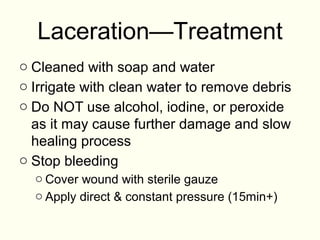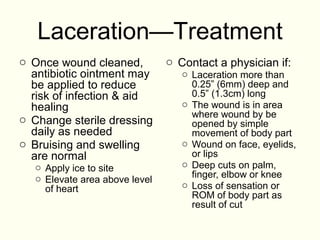Describe Skin Closures and How They Are Applied
Basics of wound closure. Eliminate the need for sutures and local anesthetic easy to apply and remove they have a lower incidence of wound infection compared to sutures they result in less scarring than sutures.
Dermal approximation provides the strength and alignment of skin closure.

. Assessing the size shape location and color of bumps blisters and rashes can help. Apply closures to each side for evenness and then fill in and cover the full wound area. ABOUT SIMPLE FLAPS AND CLOSURE.
A scar is collagen-rich skin formed after the process of wound healing that differs from normal skin. Wound closure is one of the more challenging aspects in trauma care. In the second form the laser drills tiny holes into deeper layers of your skin or fractional resurfacing.
The epidermis and dermis are tightly adhered and clinically indistinguishable and together constitute the skin. It usually requires additional resection of skin beyond the necessary margins of excision of a lesion. Last updated on 121318 First published on 1218 Literature review current through Feb.
Beneath the dermis lies the hypodermis which is composed mainly of loose connective and fatty tissues. An abrasion means that the surface layers of the skin epidermis has been broken. Nerve fibers blood vessels.
Basically these stitches under the skin dissolve over a period of 3-4 months. Diagonal running lock and straight stitch closure are discussedThis video is the sixth of six surgical. Clean at least 3 inches around the wound making sure to remove all debris skin oil and exudates.
Fascia are the tissue layers of concern in wound closure 2. Do not pull too hard trying to reduce tension with sutures as that can lead to further wound breakdown. An erosion with loss of the epidermis caused by scratching.
Thin-skinned bony areas like knees ankles and elbows are more prone to abrasions than thicker more padded areas. In general the goal of treatment is to obtain a clean closed wound involving as little time and the least possible physical and emotional commitment for the patient. When placing deep sutures absorbables eg gut Dexon Vicryl.
They are easily accessed for removal. The subcutaneous layer is mainly comprised of adipose tissue. Most cuts or wounds with the exception of ones that only scratch the surface the epidermis lead to scar formation.
P List affective skin antiseptics. Good approximation of wound edges is paramount to proper wound closure technique. There are two forms of laser resurfacing.
The clinicians care for wounds ranging from minor and simple lacerations or abrasions to complex wounds. Fluid-filled bump under or in the epidermis the surface of the skin that is less than 1 cm in size. Figure 1C shows the excision site after removal of the sutures and polyethylene film on the left tibia of a 95-year-old woman.
For injuries that require. First aid treatment includes. The goals of wound management are to avoid infection tamponade the bleeding and provide a better cosmetic outcome.
Sometimes called healing by tertiary intention delayed primary closure is a combination of primary and secondary closure. Wounds that heal by primary closure have a small clean defect that minimizes the risk of infection and requires new blood vessels and keratinocytes to migrate only a small distance. Enclosed sac in skin containing fluid or solid material.
First aid for abrasions. It is important to remember that no method of wound closure or treatment is able to. In the first form laser resurfacing creates a uniform injury to your skin similar to deeper chemical peel or dermabrasion.
Wound management is an essential part of emergency medicine practice. Surgical incisions paper cuts and small cutaneous wounds usually heal by primary closure. These wounds do not usually trouble the wound care specialist.
The wound is cleansed and is watched closely for several days. A holistic skin assessment should include physical examination and individual assessment of psychological and social effects. To diagnose skin conditions doctors typically consider a persons medical history and physical symptoms.
Sometimes the secondary changes make it impossible to see and describe the primary lesion scale lichenification keloid excoriation fissure erosion ulcer atrophy crust hyperkeratosis. Formation of dried blood plasma or pus over a break in the skin. Changes which occur as a result of the natural development of or due to external manipulation of the primary lesion.
Wound closure techniques have evolved significantly and now range from simple sutures to adhesive compounds and techniques have also improved. Allow the skin to dry or pat dry with gauze squares. The skin is composed of two main layers.
Touch is a critical component of skin. Use skin adhesives andor glue in conjunction or an adjunct to sutures or staples to strengthen the closure of your wound. A novel method of skin closure is detailed for surgical removal of tumors in patients with aging or thin and fragile skin.
This is the most straightforward technique of closure of a skin defect. Use transfer forceps with sterile gauze to apply antiseptic. Cleanse the site using antiseptic swabs such as Betadine or alcohol.
Key skin assessment and language of dermatology learning points. However in some situations a single-layer closure is adequate. The resection of skin is done to change the defect shape from a round or an oval into a fusiform shape that can be closed as a line.
This may entail the placement of deep sutures subcutaneously or in the deepest layer of disrupted tissue. This video shows skin closure stitches to include. The language of dermatology is terminology that should be used when describing skin eruptions or lesions.
The scraped skin of an abrasion can contain particles of dirt. Scarring occurs in cases in which there is repair of skin damage but the skin fails to regenerate the original skin structure. Delayed primary wound closure.
During that time they guide the healing. By implementing a set of dissolvable stitches in the deeper subcutaneous layer under the skin you are able to offset the large amount of stress that would be put upon stitches that are used in the outer layer of skin. This type of closure is often preferred when a wound is heavily contaminated to reduce the risk of the wound becoming infected.
Adhesive butterfly closures can be applied to. The epidermis made of closely packed epithelial cells and the dermis made of dense irregular connective tissue that houses blood vessels hair follicles sweat glands and other structures. What are three advantages of adhesive skin closures.
Gently scrub the wound using an antiseptic solution and a sterile gauze pad or a surgical scrub brush. Care of an incision or wound with a closure application. A deep cut or tear in skin or flesh.
Ensure that the area to which a bandage is applied is clean and dry do not apply a bandage directly. Steri-strip closure to the center of the incision.

Amputation Of Lower Limb And Hip Lower Limb Musculoskeletal System Innominate Bone

Fivetwo Beauty Sio Beauty Giveaway Beauty Giveaway Beauty Aging Signs


No comments for "Describe Skin Closures and How They Are Applied"
Post a Comment